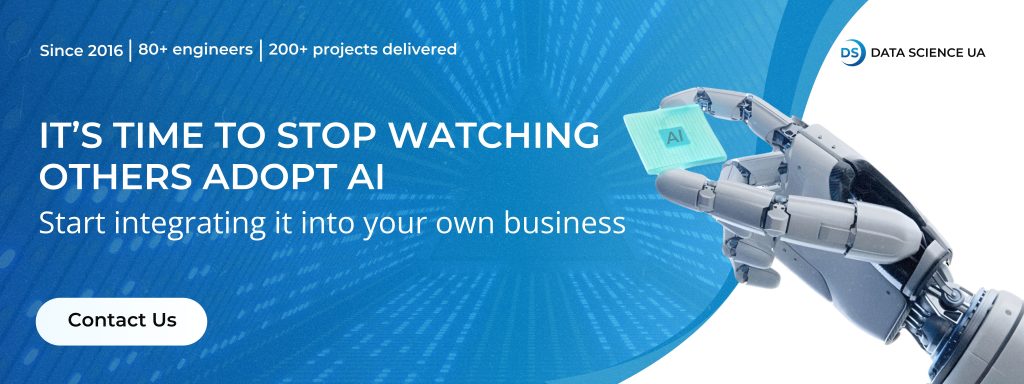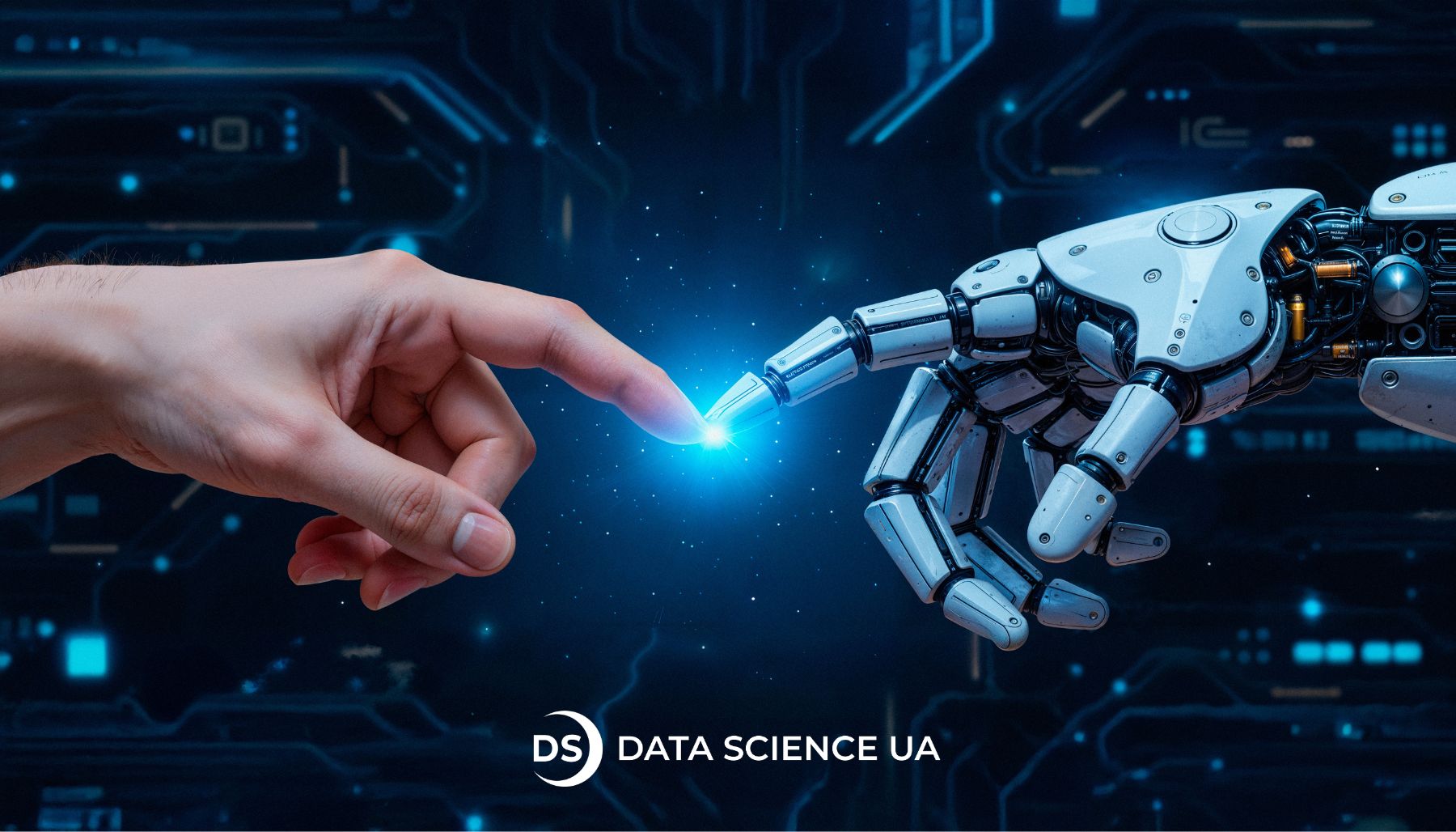AI in ecommerce examples: Top case studies
How AI is transforming the eCommerce industry
The e-commerce market is changing from the inside. In conditions of overheated competition, it is not the one who simply does more who wins, but the one who does more accurately. It is here that AI has become the backbone technology for e-commerce teams that think one step ahead.
AI development services today are not about future scenarios. In this article, we will explain why you need to implement AI in ecommerce NOW!
Enhancing customer engagement
In online trading, retaining a client is more expensive than attracting one. And at the same time, users increasingly expect to be understood without words. In this context, Machine Learning services solve several problems at once.
Firstly, they allow you to analyze the user’s behavior in real-time: what he looks at, how much time he spends on the page, and at what stage he falls off. This data is used for accurate personalization, not at the level of “similar goods”, but taking into account behavioral patterns, purchase history, and even the context of the current session.
In the health & beauty market, where each consumer makes dozens of micro-choice purchases in one trip to the store, classic marketing metrics don’t work. The retailer turned to Data Science UA with a request: how to understand why customers are switching to other chains, why the average check is not increasing, and how to accurately recommend products.

What’s stopping you from implementing AI into your business?
Recommendation engine
Thanks to machine learning algorithms – LightGBM and TensorFlow – they made personalised suggestions in the shopping cart. As a result, the average check increased: customers started adding up to 0.4 more items.
Early churn detection model
By analysing customer purchase and behavioural profiles, they created a scoring system: if the probability of leaving the network is > X%, the system generates a set of recommendations (discount, bonus). As a result, the churn rate dropped from about 20% to 15%.
Secondly, the automation of communications based on ML models helps to go beyond classic e-mail marketing. We’re talking about dynamically tweaked content, push notifications, and product recommendations that are really relevant.
As a result, the average check is higher, the outflow rate is lower, and marketers have less manual work.
Smarter data-driven decisions
One of the main obstacles to growth for eCommerce teams is an overabundance of data in the absence of time and resources to comprehend it. However, most procurement, promotional, logistics, and customer support decisions are still made manually. Sometimes, on intuition.
AI allows you to move from “reacting to problems” to predicting them. Predictive models provide answers to simple but critical questions:
- What products are worth promoting next month?
- How much should you buy so as not to freeze money in the warehouse?
- How many operators do you need to plant in support during peak hours?
The main thing is not to overload the system. It all starts with a clearly formulated business question and a minimal set of data. Even a small ML model based on historical data can give an increase in efficiency already at the first stage.
Automating content generation
Automatically generating content from existing templates and attributes accelerates operations and reduces costs.
The result in SEO is especially tangible. Search engines better index pages with relevant and unique content. Instead of copy-paste or outdated cards, structured texts correspond to search queries.
Important thing: We are not talking about replacing content commands. It’s about offloading them from routine mechanics and giving them time to do strategic work.
Optimizing daily operations
AI has an effect not only in the client interface, but also in the “backstage”: logistics, support, procurement planning, and stock management.
For example, in returns, you can train the model to identify potentially problematic orders before the customer receives them. In logistics, to predict delivery times taking into account external factors. In support, classify calls by complexity and urgency so as not to waste time on forwarding.
It allows you to reduce costs at each stage and make processes scalable, without the need to constantly increase the team.
Essential AI tools for e-commerce success
AI tools in e-commerce are not a matter of status, but an element of survival. When competitors work with millions of users, you can’t afford to blindly act. Here, we will reveal the main technologies that have a direct effect: from revenue growth to cost reduction.
Smart recommendations
The old recommendation model – tag-based “similar products” – no longer works. The user expects to be shown what he can actually buy. And the sooner, the better.
Artificial intelligence-based recommendation systems analyze the buyer’s behavior not only at the moment, but also in dynamics: what goods he looked at, where he stayed, what he put in the basket, but did not buy. On this basis, AI forms individual collections of goods.
As a result:
- Average check increases.
- More likely to buy again;
- Reduces the burden on marketers.
This is especially true for large directories where manual configuration of recommendations is not possible.

Contact us for more information about AI in ecommerce!
Dynamic pricing
Prices in e-commerce have long ceased to be fixed. Competitors change them daily, and users compare them at several sites.
AI platforms help automate this process. They collect data from marketplaces and analyze demand, seasonality, balances, shipping costs, and even the behavior of individual users.
Based on these factors, the system changes the price in real-time, without the intervention of managers, and this is effective when working with large categories and during periods of stock or sales. A prime example is airlines. They have been using dynamic pricing systems for many years: the price of a ticket can change in minutes depending on the occupancy of the flight, the date of departure, the time of day, the user’s search history, and even the routes he or she has opened before. The same logic is now being adapted for retail, e-commerce, SaaS, and subscription models.
AI chatbots
AI-powered text assistants have long outgrown the role of “answering 3 questions”, but modern AI chatbots give us more benefits. The key difference is in reducing the support burden. Businesses don’t need to scale the call center with the growth of orders. And at the same time, the quality of interaction with the user doesn’t fall.
AI bots work 24/7, don’t get tired, don’t pause, and don’t send the client to “wait for the operator”. It is important for shoppers, especially at night and on weekends.
Predictive analytics
AI in ecommerce predictive analytics helps answer questions:
- What items will be on sale next month?
- Where can logistics failures occur?
- Which customers are highly likely to leave?
For example, if demand for the electronics category is growing in a particular region, the model may suggest where to increase advertising activity or redirect stocks.
Forecasts are based not only on internal data, but also on external sources: weather, holidays, macroeconomics, and trends in search queries. It makes planning more accurate.
5 key advantages of AI in retail
Personalized shopping experiences
Every client expects to be heard. But with thousands of visitors a day, it is impossible to provide this manually. AI helps retailers show customers exactly what they might really be interested in – on the website, in the application, in email, and even at the point of sale.
AI systems analyze data: what a person bought before, how they behaved in the application, and what he is looking for now. On this basis, a personal showcase is built for everyone.
The benefits are obvious:
- Increased conversion
- Increased loyalty
- Reduced time to choose
The larger the assortment, the stronger the effect.
Smarter business decisions
Intuition is good at the start. Then those who work with numbers win. AI helps process large amounts of data: sales, logistics, marketing, demand, and returns. At the exit, understandable recommendations: what to change, what to strengthen, where to slow down.
This is especially useful for:
- Procurement planning
- Calculation of discounts
- Marketing performance assessments
There is no need to build complex Excel models manually – the algorithms themselves find connections and anomalies.
Cost efficiency & higher ROI
AI allows you to do more at a lower cost. Automation of processes has an effect in the first month. AI applications in ecommerce:
- Chatbot instead of part of the call center
- Predictive replenishment algorithm – instead of overstock
- AI feedback analysis instead of manual moderation
Cost reduction is combined with revenue growth. This improves ROI faster than classic automation.
In addition, AI models are easily scalable. Business grows – no need to re-hire people or rebuild processes.
Strengthened security measures
Fraud, fake accounts, suspicious activity – all this has long become part of digital retail. AI is capable of tracking suspicious patterns in real time.
It sees:
- Unnatural changes in user behavior
- Abnormal orders
- Mass generation of feedback
And react before it becomes a problem. AI also helps detect vulnerabilities in operational processes – from logistics to sales – that are difficult for a person to track.
Improved inventory management
One of the most painful topics is warehouse management. An oversupply of goods freezes money. Deficit – loses sales.
AI models are able to predict demand not only by sales history, but also by taking into account:
- Weathers
- Advertising campaigns
- Competitor behavior
Local holidays
This allows:
- Reduce surplus
- Avoid empty shelves
- Optimize logistics
As a result, the burden on the procurement and logistics team is reduced, and inventory turnover is growing.
Top examples of AI in ecommerce
Personalized recommendations
Recommendation algorithms are one of the most obvious and proven AI in ecommerce examples. Thanks to machine learning, the platform analyzes the user’s behavior – his clicks, views, purchases, preferences – and generates personal offers in real time. This increases conversion, increases the average check, and improves the user experience.
For example, Amazon, one of the examples of AI in ecommerce, uses a complex recommendation system that they estimate generates up to 35% of total revenue. ASOS applies AI to create personalized storefronts for each user. And the Ukrainian Rozetka has implemented its recommendation engine, which offers goods based on the interests and previous behavior of the buyer.
AI-enhanced product discovery
Product search is one of the most painful points in e-commerce. The user often does not know the exact name, makes typos, or simply cannot describe what he needs. Here, use of AI in ecommerce solves several problems at once: it improves the relevance of the results, takes into account the context, prompts the wording, and also learns from user scripts.
One of the most famous AI in ecommerce examples, Shopify, has integrated an AI module that helps you find the right products faster and reduces rejection rates. IKEA uses AI in the mobile app: the user can upload a photo of the interior, and the system will offer suitable products that fit into the style. This is not just an improvement in search – it is a reduction in the time to choose and an increase in the likelihood of buying.
Image recognition technology
Image recognition is an important part of e-commerce, especially in fashion, home decor, and electronics. Using image recognition, the user can simply upload a photo of the product they like, and get a selection of analogues or exact matches in the store’s catalog.
ASOS and Zalando actively use this approach: the buyer takes a photo on the street or from Instagram, and the algorithm finds similar things in their assortment. This shortens the journey from desire to purchase and makes the process more intuitive.
Developing such solutions requires an expert approach, and if you are considering implementing image recognition at home, you should contact specialized partners. For example, our company provides image recognition software development services, adapted to business needs: from fashion retail to automotive marketplaces.
AI for fraud & review detection
AI allows you to analyze behavioral patterns in real time, identify suspicious activity, block fakes, and signal to the security team.
Shopify: How AI catches fraudsters faster than they can click ‘Pay’
Behind the scenes, one of the most powerful tools for fighting online fraud is at work. The moment a user clicks the “pay” button, the system has already analysed dozens of factors: whether the IP address matches the delivery region, whether the buyer is behaving too suspiciously, whether he or she has been previously seen in returns and strange transitions between pages.
Fraudulent activity is getting smarter and more aggressive these days, and for Shopify, fighting it is a matter of reputation and seller safety. That’s why there’s AI at work here, which doesn’t just tick the “suspicious” box, but is able to predict the risk before the transaction is even completed. The support team gets a signal, and the potential fraud is blocked. For millions of users, this has become an important, albeit invisible, element of trust in the platform.
Amazon: Are fake reviews no longer a problem?
If you’ve ever read a review of a product that said something like ‘great quality, I bought 10 of them and I’m happy with everything’ – you may be looking at the work of a fake reviewer. Amazon has been fighting this for a long time, but now at the neural network level.
The system tracks everything: how often the account writes reviews, how much time has passed since the purchase, and whether the phrase is repeated in other product cards. But most importantly, the algorithm has learnt to detect hidden connections: if the same ‘buyer’ praises a certain seller regularly, it is a reason to be wary.
Users themselves often do not notice this struggle, but it affects how honest and useful your next purchase on Amazon will be. And yes – it’s AI that filters those weird 5-star reviews that are written as if they were generated by a robot (and maybe they were).
eBay: When AI knows more about you than you know about yourself
At eBay, fraud-fighting is turning to behavioural analytics. And it’s not about ‘you clicked a weird button’ – the system looks at behaviour as a whole. How fast do you buy? How many returns have you made in a month? Does your delivery address change too often?
If you’re a regular shopper, you won’t notice this. But if you are building schemes for mass returns or ‘spinning’ the rating through fake orders, the system will realise it. And yes, fake sellers get hit too.
Violation scenarios are constantly changing, and that’s where machine learning comes in – it adapts to new behaviours and keeps up with those who try to ‘get around the system’. This keeps eBay a marketplace where trust between buyers and sellers is more than just a slogan on the home page.
Dynamic pricing strategies
Dynamic pricing has become a key tool for e-commerce companies to adapt to rapidly changing market conditions.
AO World, a major online retailer of home appliances and electronics in the UK, has applied dynamic pricing to improve competitiveness. It resulted in a revenue increase of more than 15% in one financial year.
Contact us to know more about our services!
Counterfeit product detection
Fakes are a real threat to examples of artificial intelligence in online shopping, especially in the fashion, luxury, and electronics segments. AI helps recognize counterfeit goods before they reach the consumer.
Alibaba is one of the leaders in the fight against fake goods. The platform uses AI, which analyzes ad texts, images, and seller behavior, to identify signs of counterfeiting.
Customer service chatbots
AI-based chatbots work 24/7, respond quickly to customer requests, and reduce the burden on call centers. They are especially effective in the field of e-commerce, where it is important to quickly process returns, orders, and delivery clarifications.
KLM Royal Dutch Airlines: a bot that doesn’t lose suitcases
When air travel became massive, passenger support – before, during and after the flight – became an operational headache. Dutch airline KLM was one of the first to introduce an AI chatbot on Twitter, WhatsApp, Facebook Messenger and even WeChat.
The bot answers questions about departure times, boarding passes, baggage rules and even helps select seats. It is synchronised with the airline’s internal systems, so it can quickly report flight delays or remind you to check-in.
Most importantly, it learns. The more passengers ask, the more accurate its answers become. The result is a reduction in the load on call centres and a noticeable increase in customer satisfaction in post-flight surveys.
To implement such solutions, NLP is used – technologies that allow machines to “understand” human language. You can learn more about this at natural language processing services.
Future trends in AI for ecommerce
Hyperpersonalisation is no longer about “similar products”. Recommendation systems now take into account your search, likes, lags on the page, and items in your basket. But what is coming up is the analysis of micro-interactions: how you browse the page, what caught your eye in the product card,and in what order you clicked the buttons. Such signals allow us to anticipate not just the need, but the mood and context – for example, to distinguish between ‘I’m looking for a gift’ and ‘I want to update my wardrobe’.
Interactive shopping will replace fitting rooms. Cosmetic brands (L’Oréal, MAC) and fashion retailers (Zara, H&M) are already testing AR solutions that allow you to try on a lipstick or jacket right in your browser. A camera, a few seconds of processing, and you see yourself in a new look without going to an offline shop. It’s not just a wow effect – such technologies increase conversion rates several times over.
Logistics automation will become the norm, not an innovation. In the coming years, more and more warehouses and distribution centres will switch to AI control. Robots will collect orders themselves, and AI programmes will calculate optimal delivery routes taking into account weather, traffic, and urgency. Amazon and JD are already on this path, showing how to cut costs and speed up delivery times.
Voice assistants aren’t lagging behind. Shopping via Google Assistant, Alexa, or Siri is becoming more and more convenient. Instead of searching a website, it’s a voice command, ‘order cat food like last time.’ Companies that are already investing in voice commerce will have an advantage in a market where every click is minus a conversion.
6 useful tips for introducing AI in retail
1. Evaluate business goals. Don’t implement AI in ecommerce “for the sake of a tick”.
2. Identify bottlenecks: high customer service costs, low conversion rates, inefficient inventory management.
3. Start small. Test AI on a single task – for example, support automation or dynamic pricing, or use smart and ready-to-use decisions. For example, test the automation of the support service or connect dynamic pricing for one product category. It will give you the first figures and an understanding of how AI can work in your context.
Another way is to use off-the-shelf solutions. There are already smart tools on the market that can be quickly implemented and adapted to specific business tasks: from anti-fraud to personalised recommendations.
And if your team is not yet ready to take on the technical details, Data Science UA offers corporate AI education and assistance in selecting the optimal tool stack.
4. Prepare the data. Algorithms work effectively only on high-quality and structured data. If the data is chaotic, the result will be unpredictable.
5. Find a technology assistant. It doesn’t always make sense to build a team inside. Use the AI agent development services of Data Science UA experts to speed up launches and reduce risks.
6. Train the team. Even the smartest model will not be useful if employees do not understand how to work with it.
Is it better to start NOW?
AI is not just a trend, but a stable vector of e-commerce development. Companies that learn how to properly use machine learning, NLP, and computer vision technologies will gain a competitive advantage today.
The transition to intellectual trade requires effort, from data analysis to restructuring internal processes. But those who take this step now will be one step ahead in the future.
If you are considering implementing AI in your business, start with diagnostics. Think about where you’re losing customers, money, or time, and look for a solution there. AI is not magic, but a tool, so it’s important to know how to use it correctly.
FAQ
How does AI improve customer service in online retail?
Customer support used to mean long wait times and generic replies. Now, thanks to AI in ecommerce, things are different. Smart chatbots can jump in the moment a user needs help, answer basic questions around the clock, and even adjust their tone depending on who they’re talking to.
What difficulties do e-commerce companies face when implementing AI?
The tech can be expensive, especially upfront. Many teams realize their data isn’t clean or complete enough for training algorithms. Add to that a lack of in-house AI expertise, tricky integrations with old systems, and some very human resistance to change, and you’ve got a pretty steep hill to climb.
What measurable results did e-commerce companies show after implementing AI?
Businesses record an increase in conversion, an increase in the average check, a decrease in operating costs, and more accurate forecasts of demand and customer behavior.






